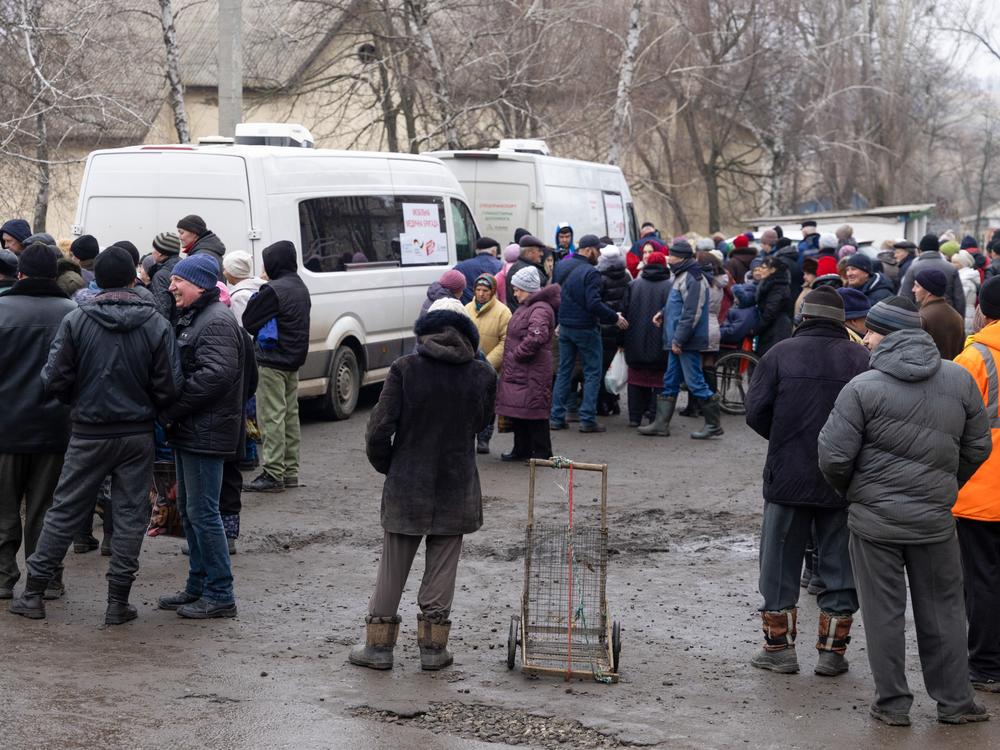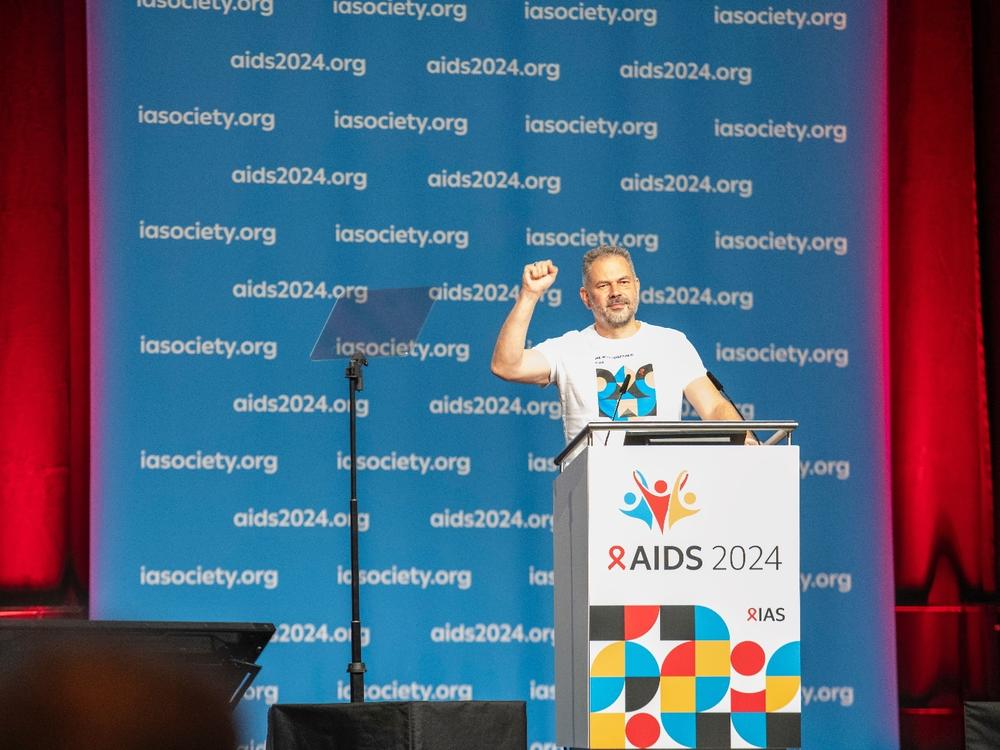Section Branding
Header Content
Ukraine keeps up the fight against HIV while fighting a war
Primary Content
How do you fight HIV infections in the midst of a war?
That’s a question that’s been bedeviling Ukraine since the Russian invasion of February 2022.
It’s a critical issue for a country that, with an estimated 245,000 people living with HIV, has the second highest incidence of the infectious disease in Europe after Russia, with the virus typically spreading through contaminated blood, sexual contact and shared needle usage.
“After the fall of the Soviet Union, injectable drug use was very, very high across all former USSR countries,” says Dr. Ksenia Voronova, an infectious diseases doctor who works for AIDS Healthcare Foundation Ukraine. “There were a lot of cheap, high purity drugs, and people would gather together and share needles. It was one of the main reasons for the fast spread of HIV. “
A threat to past progress
Ukraine turned the corner in its battle to control HIV in 2012, when the annual rates of new infections declined for the very first time, from 17,300 people being newly infected with the virus in 2011 to 16,847 the following year. This reduction followed the implementation of contact tracing to rapidly identify newly infected individuals and provide them with access to antiretroviral drugs that suppress the virus. Injectable drug users were offered opioid substitution therapy such as methadone or buprenorphine, which provided them with a pathway to stabilize and eventually tackle their addiction.
“Ukraine has always been, I believe, at the forefront of HIV prevention,” says Tetyana Vasylyeva, a Ukrainian epidemiologist now based at UC Irvine. “These initiatives, which helped find undiagnosed people and link them to care, were tested in Ukraine and have since been adopted by many countries in Southeast Asia and Africa.”
“Things were on a good trajectory,” she says.
But when war came to Ukraine in early 2022, Vasylyeva was immediately concerned that much of this progress would be undone.
By early 2024, the fighting had already displaced an estimated 3.7 million people within Ukraine and another 6.3 million fled the country. So far, Russian bombardments have completely destroyed 214 medical facilities and damaged more than 1,600, with the biggest losses in eastern Ukraine. National health-care spending declined from 12% of the budget to just 5% while defense expenditure soared from 9% to 55%.
Coming up with solutions
But despite limited resources, the groups leading the effort to address HIV have improvised solutions, from organizing medical missions in war-torn regions close to the front line, to rolling out new preventative medications that can protect people from the virus for weeks at a time.
The Alliance for Public Health, a Ukrainian advocacy group working to fight HIV/AIDS, tuberculosis and other infectious diseases in the country, was able to procure emergency antiretroviral supplies through U.S. donors such the Global Fund and PEPFAR — treatments previously purchased in large quantities by the Ukrainian government. But the Alliance still faced challenges in administering care, as many trained health-care professionals with expertise in managing HIV left the country.
“At the time, I was trying to establish a research project in Ukraine, and the lack of skilled professionals with experience of working in HIV services was pretty dramatic,” says Vasylyeva. “Of course some people stayed, but their workload tripled.”
At the same time, Ukraine was experiencing a dramatic population displacement as millions fled from the east to the relative safety of western cities like Lviv.
Andriy Klepikov, the Alliance’s executive director, says that as a result of this population movement, demands soared for so-called Pre-Exposure Prophylaxis (PrEP) drugs, which are 99% effective at preventing HIV transmission through sex and 74% efficient at preventing HIV infections through drug use.
But even as the Alliance and other organizations attempted to help the influx of people fleeing to the west, they worried about the health of those still in war-torn eastern Ukraine. Studies showed that the stresses of war were driving a sharp rise in the use of injectable opioids. And with hundreds of hospitals and clinics razed, access to health care was extremely limited.
Within a few months, the Alliance estimated that without intervention, this could ultimately lead to hundreds of new infections.
Bringing help to the 'Red Zone'
In December 2022, a small team of doctors, nurses and lab technicians embarked on their first mission into what the Ukrainian government calls the Red Zone, an area of roughly 6,000 square miles. It encompasses the rural towns and villages of eastern and central Ukraine which lie between five and 50 kilometers from the front line. This mission represented the first step in an ongoing project launched by the Alliance to restore some form of health care to Ukraine’s most vulnerable citizens.
Pavlo Smyrnov, deputy executive director of the Alliance, recalls that the initial journey took them on icy roads winding through fields on the outskirts of Kupiansk, a city that had been captured by Russian forces in late February, and liberated seven months later in early September 2022. The crew travelled in vans equipped with a small lab, capable of analyzing rapid HIV tests, and stocks of vital medications. Smyrnov says the team could hear the rattle of gunfire just three or four miles away, but were still able to provide general medical care to around 70 people.
Since then, similar missions have been undertaken to 230 towns across the Red Zone, administering just over 1,000 HIV tests and uncovering 12 previously undetected cases in the process. The team also carried out tests for tuberculosis, hepatitis C and syphilis.
With battlefield lines continuously being redrawn, these missions come with their own risks. Phones must be switched off to avoid detection from the Russian army and low-flying military planes occasionally whizz through the treetops, just 30 feet or so from the ground, to avoid radar. Smyrnov says that at times the fighting has been so close that the van’s windows have been shaken by the rumble of incoming artillery.
“Our team protocol is that when that happens, we pack up and leave immediately,” he says. “Because there is a possibility that the next shot will be on your position. It’s quite hair-raising.”
Still, these mobile clinics may become more widespread. The Alliance says that Russia has continued to bombard Ukraine’s energy facilities to an extent that electricity blackouts last for much of the day, but the mobile clinics are powered by their own independent generators and can work through the disruptions.
UC Irvine’s Vasylyeva recently traveled to Ukraine to help set up mobile testing across major cities. “It’s really hard to run HIV tests in a traditional laboratory when there’s no electricity for up to eight hours a day,” she says. “But with these mobile labs, we can still get testing done, even if the electricity goes down for a really long time.”
Her project is in partnership with the L.V. Gromashevsky Institute of Epidemiology and Infectious Diseases, one of Ukraine’s leading scientific institutions studying HIV and other infections within the country.
Reaching out to refugees
Other efforts are working to help displaced Ukrainian refugees get HIV support in their new countries. The Alliance for Public Health says it has had success with telemedicine.
Over the last two years, the group introduced a digital service called the HelpNowHub, which runs on encrypted social media channels like WhatsApp and Telegram. It has addressed more than 50,000 requests from Ukrainians living with or affected by HIV, helping them access antiretrovirals and HIV prevention medications in their new country as well offering translation support to help them navigate their local health care services.
A new generation of preventive drugs
There is also hope in the form of a new generation of pharmaceuticals, which were the focus of considerable optimism at the AIDS 2024 conference in Munich last month. A longer-acting form of the preventative drugs taken before HIV exposure (PrEP) called cabotegravir is drawing particular attention. It prevents HIV from entering cells and could make it far easier to stop chains of new infections. While previous forms of PrEP had to be taken daily, cabotegravir only has to be injected once every two months.
Clinical trials conducted in the U.S., Latin America and sub-Saharan Africa found that cabotegravir reduces the risk of contracting HIV by anywhere between 66 and 89%, and this month, a new trial of the drug has begun in 100 homosexual men in Kiev and Lviv.
“Cabotegravir is the talk of the town everywhere right now, but particularly in a country like Ukraine where the situation is so volatile, you don’t know whether your health-care facility will still be standing next month, it can be crucial,” says Vasylyeva of UC Irvine. “So the longer you can go without needing contact with your care provider, the better.”
But while Vasylyeva is optimistic about Ukraine’s ability to continue driving down infection rates, the situation in the Russian-occupied cities of eastern Ukraine remains uncertain. Here, the Ukrainian HIV charity, 100%Life, fears that the epidemic is being silently fueled by forced sex work.
Vasylyeva admits that there is no data on HIV rates among these regions as testing has all but stopped, but she and others strongly suspect that rates are rising.
“I’m scared to think about what’s happening in these territories and what’s going to happen when the war ends,” she says.
“All of us are very hopeful it will end in Ukraine’s favor, but even then, there will need to be a lot of adjustment to make sure that HIV cases in these areas don’t seed outbreaks in the rest of the country when Ukraine is unified.”
David Cox is a freelance health journalist who has written for publications around the world including NPR, The New York Times, Wired and The Guardian. He has a Ph.D. in neuroscience.


